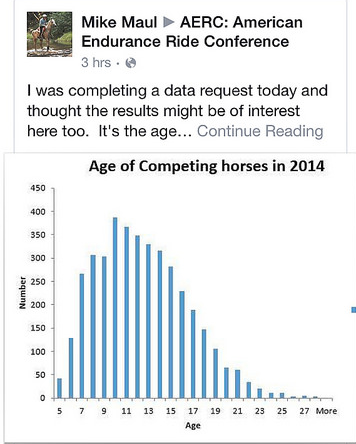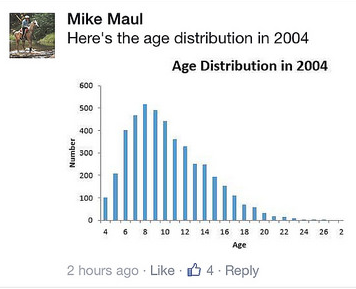Oct 2015 Link Luv
| October 4, 2015 | Posted by Melinda under Uncategorized |
A couple days late….but we are back on track with a link luv at the BEGINNING of the month. Sorta. Enjoy!
Doing endurance is a lot like riding an endurance ride. Never hurry, never tarry. Take advantage of the easy sailing trouble stuff and GO, and when it gets rocky or technical, walk, and make sure you take full advantage of your holds.
Is ultrarunning a haven for recovering addicts? I’m not one and I’m not sure that I represent a minority. All of us seem to have our quirks and at least one label (OCD, depression, ADHD) if we want it, but I’m more and more convinced that’s true of everyone and isn’t unique to people who decide to run ultramarathons. BTW, the article actually shows what a it dachshund looks like…a rarely seen creature…
Running hacks – I agree with most of them, although running in the mornings is just not sustainable for me for some reason. Also, why aren’t Brittany’s represented as a running breed?????? They are darn near perfect IMO in both size, energy level, and even their hair coat does a good job of both protecting them and shedding stickers. Not one foxtail in Tess’s feet in 4 years of running in a foxtail dense area. BTW #’s 2,4,5,7 are my favorites and are THE reason I’ve been able to run consistently over the last couple of years.
This article is about body weight, but has several good concepts that could apply to anything you are trying to do that requires daily choice. Goes outside the box and points out things like “In fact, I think you’re likely to experience decision-fatigue if you have to consciously choose to do something that is at odds with your environment dozens of times a day. ” which is something to consider.
Not endurance related…..but if you ever wanted to see inside my brain, this is a pretty good representation...The weird thing is when my brain isn’t working like this I’m strangely sad. Everything seems a little more flat and less colorful and it’s usually a sign that things are not going well.
Remember in my Tevis post this year I reminded everyone that the stories that come out of the event are part truth, part complete bull$h*t, and part spin? Here’s a Tevis recap that is as full of spin as I’ve ever read. Sorry it doesn’t matter how good your horse looks you don’t get to continue after six minutes over time. And that’s the nicest thing I can say about this article so I’ll be quiet now.
Bill Gore and Baylor photography took my 2013 Cougar Rock photos (that turned out PERFECTLY. Thought this was a nice article highlighting him, his background and his love of this sport.
I do a lot of euthanasias in my practice. A function of the area I live in and (I would like to think) the trust that this clinic has built over the years with the community. Most owners struggle with the question of “what is the right time?”. It’s complicated and a grey area and I think this is an excellent article. It’s not about just one thing, and here’s something to consider. The only regrets I have personally in this area are the animals I waited too long to euthanize, not the ones I let go a little early before I *had* to.
Mike Maul compiled these graphs from AERC data and posted on Facebook. They represent the age distribution of competing horses in AERC in 2004 and 2014
Note that the numbers on the left side of the graph are in increments of 100 in the above graph, and in increments of 50 on the below graph. 
On the surface it looks like the mode has shifted “older” about 3 years – from around 8 years of age to around 11 years old. The mean (average) is probably even a couple years above those numbers, meaning that right now your “average” endurance horse is in it’s teens.
Over the years there has been some changes in the age requirements for horses starting various endurance distances which probably explains the drop off in 4 year olds competing.
As someone with a horse that’s staring late teens in the face and shows no signs of slowing down, I’m much more interested in the right hand side of the graph. It’s still a fact that a horse in it’s late teens and in it’s 20’s makes up a very small part of the population. Whether that is because most of these horses are started in the sport as the average horse as an 8-11 year old and that’s just a really long time to stay accident free and genetically lucky, or whether it represents a few folks brave enough to start their older horses in the sport and these horses are relative newcomers, I can’t tell from this data. It would be really interesting to look at each age group and see what their average number of previous seasons was.
Don’t worry, Hendra isn’t something we have in the US, but this article about Hendra in Australia is troubling on a variety of levels. The only similar-ish disease I can think of here that *might* fall into the same category is Anthrax. The difference is that with anthrax you are delaying a necropsy, not treatment, and the signs that would make me suspect anthrax belong to a very very short list of diseases and conditions, most of them toxins. Vets have a duty to their patients, their clients, society, and their employees. This is similar to the responsibilities other medical professionals have, however I would argue that vets are unique in that they can be told to watch their patients die (or kill them) or the good of all. (and I agree with the article. It is not practical to wear full PPE to handle every patient. ).
A timely article considering how much “hoof talk” has been happening on the blog and a good article (with pictures!) too about evaluating hooves.
There’s no bear stories this month, so I had to put something else completely freak-me-out-I’ll-go-to-bed-with-the-lights-on here.
YOLO. Remember the first link in this post about never hurry, never tarry, but make the most out of each moment? Yeah. Go out and DO THINGS because you never know. Prepare for the future because you never know. Being an adult is some how finding the balance between those two things.
Are you a runner or rider for life? I am and guess that I’d never even considered that there was another perspective, and just assumed that people who quit didn’t like the sport in the first place, or were burned out or injured. There’s certainly been hobbies that I’ve cycled through every 3-5 years as opportunities presented themselves and then disappeared (usually related to when/where I was in school or where I was living), but somehow didn’t imagine that people could feel that way about running or riding.
Not endurance related, but too good not to share. The role of anxiety in learning, specifically in adolescence? As a generally anxious person (who has stayed so zen on pregnancy hormones I wonder whether I’ve actually unlearned some of the anxious pathways? Will have to see!), I’m always interested in how that particular behavior trait might be molded or adapted to actually be helpful.
Another non-endurance related thing….but since this is a blog and most of my readers are also bloggers, thought I would share this post about whether blogging is “dead”. Obviously I don’t think so as I’m sitting here wasting WAY TOO MUCH time per week blogging when I could be funneling this writing into other things (like that DANG BOOK), but again I was never in it to make money. Oh sure, it’s nice when google ads or donations end up covering the expenses of running this blog (~$13/month) but that happens rarely and yet I keep going and going and going…..Anywhoo – she has a lot of GREAT points in the post, and I agree with most of them such not feeling like you are the *only* person who feels a certain way, and she’s right, it’s kinda fun to occasionally write articles that touch the nerve of easily offended people. Sorry, true confession right there :).
A good reminder about outliers and how we have a tendency to let outliers influence our perceptions of how it’s going with our horses more then we should.
I’m curious how many of you out there empathize when Saiph’s statement in this post: She [Saiph’s horse] loves me, but she loves her herd mates more, and there are days when she takes off running the second I remove her halter in the field, something that unavoidably hurts my feelings. Especially when Gracie will wait by the gate after being released until I get in the car to leave” . I have to admit that while I can feel a range of emotions while working with my horses (frustration, anger, joy, satisfaction for example are a few that come to mind that I have to manage) in response to my horse’s choices, I have a hard time recalling a time when horses “hurt my feelings”. I tend to take my horses at who they are and not look or ascribe further motives to their choices or actions. Farley can’t wait to take off at a dead gallop towards freedom and her friends when un-haltered, and as long as she does so politely without putting me in danger, I don’t mind and actually come to expect it. If she sorta meanders off or sticks around I start wondering whether something is wrong. Because she is who she is. Lately I’ve been bribing her to come to me during turn out. It’s strictly for my own convenience and has nothing to do with our feelings – it’s a business transaction. I don’t wanna tromp over to her while she stands and watches, and if she is willing to put forth some sort of effort she will get a cookie for her trouble. It’s sorta interesting to have a horse like ML that is SO PEOPLE ORIENTED – but it doesn’t necessarily mean any more to me emotionally to have a horse like that compared to the all-business Farley. Does it make me happy that ML seems so willing to spend time with me and gallops up to me as if I’m the best thing on earth? Totally. It’s like getting greeted by Tess when I get home who acts like I’m the BEST part of her day. But I have no wish to make Farley like Tess or ML. Every animal is who they are and offers what they are capable of offering and I either accept that or find a way to train what I want. How about the ever-lamented task of conditioning Farley? I get pissed/annoyed when Farley acts like an ass during conditioning because she doesn’t *feel* like conditioning but that is because I STRONGLY believe my horses should love their jobs. I don’t take it personally – that sort of behavior makes me gnaw at my finger nails because it makes me worry this is the wrong job for the horse, or that retirement is pending, or I’m missing something. In summary I have a philosophy of taking animals at face value and I cannotl ascribe them human motives that would result in hurt feelings on my part – the deliberate intention of the other party to be hurtful. It’s just not something I have found that my dogs or horses are capable of doing. I have a feeling just from observing animal people around me and the vocabulary they use, that probably about 50% of people feel the way I do, and 50% of people would describe emotions or reactions that are similar to Saiph’s. (Thanks Saiph for the thoughts on honesty on your post writing from your perspective!)
Here’s Liz’s take on anthropomorphizing.
Some day I want something to happen to me as awesome as the intro on this post: “When you’re three minutes from starting a 24-mile race, this isn’t what you want to hear. Hell, if you’re three minutes from doing anything, you don’t want to hear that you were just hit by a car.” OK OK OK. Getting hit by a car isn’t awesome. But this post was laugh out loud funny and (spoiler alert) he survived to run the race.
Yes. Just yes. As much as I compare my two horses and am overjoyed at many of the similarities, I also celebrate their differences. It is my fondest hope that I will be able to “empty my cup” when starting with ML. She deserves it.
Did I miss any awesome posts or blogs this month?












[…] those questions that I had about older endurance horses and number of seasons competing in this link luv post? The same gentleman that crunched the data and gave us those graphs kindly mined the data I *think* […]
As someone with a “squirrel” brain, thank you again for a wonderful link luv post! I enjoy reading so many of these links every month. Definitely great to just be *sent* to some good reading instead of having to drum it up for myself =)
That article on Hendra… We don’t have the disease in this state, but my heart goes out to everyone involved in the situation is Queensland and New South Wales. It’s a MESS, and the worst thing is we have a vaccine for it but people aren’t using it because of the potential for vaccine reactions! Social media and the like stir the pot, people don’t get their horses vaccinated, and then they get upset when vets won’t attend their sick horse. Entire practices are pulling out of horse work over there because of this.
I have to admit I hadn’t even heard of Hendra until I saw this link you posted on facebook. I can think of a couple of diseases I don’t vaccinate for because of vaccine reactions but NONE of them would cause consequence to human health and safety like Hendra. I can’t even imagine what the vets over there must be struggling with. What an awful situation.
[…] article almost made it into the link luv post yesterday, but was too good to just leave as a one sentence blurb in the middle of 20+ other links when I […]
Ahhhhh, I wondered what you thought of that EN article on Hilda Donahue. It smelled fishy to me.
I don’t know her but I met her at VC100 the year she attempted that ride and seemed like a nice enough person – no personal vendetta here. Some of the annoying errors can be attributed to who ever wrote the article and failed to fact check it – cougar rock comes before 36 miles check point and is NOT part of the canyons. But other errors are from Hilda herself as quoted in the article. And they are incredibly grating for anyone familiar with the Tevis cup and gives a false impression of how the ride operates and the rigor of the vetting/qualification process to proceed down the trail.
I will say that it’s actually fairly easy (and a hobby for many of us that follow the Tevis event who aren’t riding it in a certain year for some reason) to track riders in and out of checks and thus to monitor how someone’s ride is going based on times between checks and and comparing that to typical times of front, mid, back packers as well as what other rider/horse teams are doing around them who are doing similar times in real time that year etc. And since most of us has ridden the trail, we know what the trail looks and feels like and how fast people need/should/could be riding sections if they are likely to finish – and we also have a good idea of patterns that mean something is *wrong*. Sure there are exceptions, but usually…..not.
Honestly the spin related to “how me and my horse did in the ride” and how it may or may not match their actual in and out times at the various checks or what spectators preceive at the ride doesn’t bother me much – heck MY Tevis stories are full of spin as much as I try not to include it. I think it can take YEARS to be able to fully look back at a ride such as Tevis and fully admit to yourself (and accept) a truer version of the events then perhaps your mind knitted together at the time. THAT’S TOTALLY OK. However what does bother me is that some of the statements seem deliberately at odds with the rules….which suggests either she didn’t understand the rules of the event she was riding in, or some thing else?
Egads! Proofread much? Most are self explanatory but the two errors in the first two links are agregous enough to point out.
Link one “trottable stuff” no trouble stuff (thanks auto correct).
Link 2 “example of a FIT doxie dog, a rarely seen creature”.
great links. as always, thanks for pulling out of my “routine reads”!